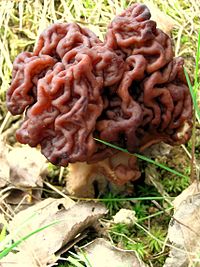Gyromitra esculenta is an ascomycete fungus from the genus Gyromitra, widely distributed across Europe and North America and one of several species of fungi known as false morels. It normally sprouts in sandy soils under coniferous trees, in spring and early summer. The fruiting body, or mushroom, is an irregular brain-shaped cap dark brown in colour which can reach 10 cm (4 in) high and 15 cm (6 in) wide, perched on a stout white stipe up to 6 cm (2.4 in) high.
Although potentially fatal if eaten raw, Gyromitra esculenta is a popular delicacy in Scandinavia, Eastern Europe, and the upper Great Lakes region of North America. It may be sold fresh in Finland, but it must be accompanied by warnings and instructions on correct preparation. It is eaten in omelettes, soups, or sautéed in Finnish cuisine. Once popular in the Pyrenees, it is now prohibited from sale for consumption in Spain.
Although it is still commonly consumed after parboiling, recent evidence suggests that even this procedure may not make the fungus entirely safe; thus raising concerns of risk even when prepared properly. When consumed, the false morel's principal active agent, gyromitrin, is metabolized into the toxic compound monomethylhydrazine (MMH). The toxin affects the liver, central nervous system, and sometimes the kidneys. Symptoms of poisoning involve vomiting and diarrhea several hours after consumption, followed by dizziness, lethargy and headache. Severe cases may lead to delirium, coma and death after 5–7 days.
